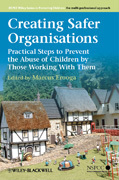
Creating safer organisations: practical steps to prevent the abuse of children by those working with them
Erooga, Marcus
An accessible resource to help those in organisational settings ensure that they have taken all possible steps to safeguard the children and young people they are responsible for.Draws on up to date research with people who have committed sexual offences against children in organisational settings, and new developments in interviewing approachesDetails recent cases to illustrate points about institutional failures in protecting children Highlights the fact that those who sexually offend against children are a diverse and heterogeneous population, and the approaches taken to protect children must address the range ofpossible risksMakes a firm commitment to the importance of multi-agency and inter-disciplinary collaboration and is relevant in both community and residential settingsOffers clear and practical messages and measures for organisationsto act on INDICE: About the Contributors xiPreface xvCreating Safer Organisations - An Overview 1Marcus Erooga1 Understanding and Responding to People Who Sexually Abuse Children Whilst Employed In Positions of Trust: An Overview of the Relevant Literature - Part One: Offenders 7Marcus EroogaPeople Who Sexually AbuseChildren in Organisational Positions of Trust - a definition 7How Prevalent are Sexual Offences Committed Against Children in Professional or Workplace Settings? 8Characteristics and Behaviour of People Who Sexually Abuse Children inOrganisational Positions of Trust 8Findings From a Study of Residents in a Specialist Treatment Setting Who had Sexually Abused Children Whilst in Organisational Positions of Trust 9Grooming 11Use of the Internet 14Motivations to Sexually Abuse 15Thought Processes and Cognitive Distortions 18Female Sexual Abusers 20Conclusions 222 Understanding and Responding to People Who Sexually Abuse Children Whilst Employed In Positions of Trust: An Overview of the Relevant Literature - Part Two: Organisations 27Marcus EroogaCharacteristics of Vulnerable Organisations’ - the Importance of the Organisational Environment in Preventing Abuse 27Corruption of Care 28Models of Authority 33Characteristics of Sexual Abuse in Specific Organisational Settings 34Motivations to Abuse 38Developing Preventative Strategies 393 Policy and Legislation - Changing Responses to an Emerging Problem 44Kerry Cleary and Marcus EroogaGeneral Organisational Legal Responsibilities 45Child care Focussed Policy and Legislation 45Department for Children, Schools and Families List 99 47Protection of Children Act (PoCA) List 48Disqualification Orders and Regulated Positions (replaced by the Safeguarding Vulnerable Groups Act, 2006) 48Sex Offender Register Notification Arrangements 49Criminal Records Checks 49Shortcomings of These Arrangements 50The Safeguarding Vulnerable Groups Act, 2006 (England, Wales and Northern Ireland) 50The Protection of Vulnerable Groups (Scotland) Act 2007 53Strengths and Limitations of Legislation and Regulation 54What Do Developments in Legislationand Regulation Indicate About Desirable Cultures for Organisational Safeguarding by Government Organisations and Individuals? 58A Model 59How Should Legislation and Regulation Support the Development of Safer Organisational Cultures?604 Sexual Abuse of Children By People In Organisations: What Offenders Can Teach Us About Protection 63Marcus Erooga, Debra Allnock and Paula TelfordIntroduction 63Methodology 64The Sample 65Findings 68Organisational Facilitating Factors 68Individual Facilitating Factors 73Discussion 79Situational Crime Prevention as a Response 81Conclusion and Recommendations 825 Manipulation Styles of Abusers Who Work With Children 85Joe Sullivan and Ethel QuayleIntroduction 85Demographic Profile and Offending Patterns of Professional Perpetrators 86Psychometric Comparisons with Intra- and Extra-Familial Child Abusers 86Rationalefor a Qualitative Methodology 87Motivation to Sexually Offend 87Victim Selection, Grooming and Abuse 89Manipulation Styles 90Conclusions 95Multi Disciplinary Issues 97Future Directions 976 Organisational Issues and New Technologies 99Ethel QuayleAn Evolving Issue 99Technology In the Workplace 100Abusive Images102Sexting 104Grooming 104Stalking 105Adult Pornography 105Misuse of Social Media 105The Individual and Organisational Abuse 106Situational Factors and Technology Mediated Organisational Abuse 108Guidelines on Child Protection Policies and Procedure In Relation to Technology 113Conclusion 1167 Safer Recruitment - Guidance for Organisations 122Kerry ClearyIntroduction 122Doing the Basic Things Well 123Importance of Values and Emotional Intelligence 124Safer Recruitment Within a Safeguarding Culture 126A Model of Safer Recruitment - PICK 127P - Plan 127I - Identify 130C-Check 134K is for Keep 136The Basics Are Necessary But Not Sufficient 137Appendix 1 Safer Recruitment Checklist 1388 Prevention Is Better Than Cure: The Value of Situational Prevention In Organisations 140Keith L. Kaufman, Hayley Tews, Jessica M. Schuett, and Benjamin R. KaufmanA Foundation for Prevention in Organisations and Institutions 141Rational Choice Theory 141Routine Activity Theory 143Defensible Space Theory 144Applying the Situational Prevention Model to Child Sexual Abuse 146A Structured Approach to Applying the Situational Prevention Model with Community Organisations and Institutions 150The Situational Prevention Model Approach to Assessing Local Organisational Settings 151Identifying Common Risks Across National Organisations and Institutions 161Situational Prevention Model Children’s Hospital Consultation - a Case Study 163The Boys & Girls Club Child Sexual Abuse Prevention Self-Assessment Initiative 164Conclusions 1669 Avoiding and Managing Allegations Against Staff 170Jo GreenIntroduction 170The Incidence of Allegations 171Behaviour That Gives Rise to Allegations 173Procedural Fairness Within a Precautionary Approach 174Characteristics of a Safe Organisation 186Index 188
- ISBN: 978-1-119-97268-6
- Editorial: John Wiley & Sons
- Encuadernacion: Rústica
- Páginas: 208
- Fecha Publicación: 27/04/2012
- Nº Volúmenes: 1
- Idioma: Inglés
